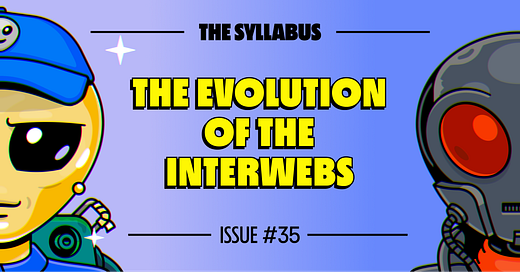👋 Welcome to the 35th issue of The Syllabus from Invisible College — a weekly newsletter that helps you navigate the fast-moving world of web3. To get this newsletter delivered to your inbox, subscribe here:
Invisible College Updates
Intro to Web3 Cohort-Based Course – In this FREE 4-week course, you'll learn about web3 by getting your hands dirty and receiving hands-on help from the Invisible College staff. This first cohort starts on Wednesday, October 19th and it’s limited to only 20 people. Learn more about the course, RSVP, and fill out the application form here.
AI Art Seminar – We’re hosting a deep-dive seminar on the AI art tool Stable Diffusion for Decentralien NFT holders next Thursday, October 13th. Join Laura Rafferty, an NFT artist, bestselling coloring book illustrator, and teacher. She has developed an AI workflow that she will teach during this in-depth seminar. RSVP here.
Learn how to join Invisible College and become a Decentralien holder here.
Now onto this week’s post…
There’s this saying that makes the rounds in web3 circles every once in awhile:


It makes for a nice pithy tweet. But having grown up with the web, that wasn’t really what happened at all.
A better breakdown would be:
web1: Connection
web2: Monetization
web3: Ownership
Let’s dive into the details…
web1: Connection
web1 was predominately running this experiment: what would happen if we digitally connected people?
It quickly led to an explosion of reading and writing all over the web—in chat rooms, forums, group chats, and marketplaces.
web1 had a ton of read and write activity—eBay, Craigslist, Wikipedia, Geocities, Live Journal, and a myriad of other websites. It’s preposterous to claim web1 was somehow static and not interactive. There were even a number of web1 social media sites, such as Classmates and Ryze.
Did all of this become more sophisticated to the nth degree with the rise of Facebook, Twitter, Instagram, Snapchat, etc? Absolutely. But they emerged as an evolution of those early experiments, not a completely different phase of the web.
TikTok evolved from existing social media sites and on many quantitative metrics, outdoing its predecessors by a significant margin. But it would be silly to claim it’s ushering in a new era of the web.
web2: Monetization
web2 was all about the tech industry waking up and realizing, "omg, if we don't figure out a way to make money, all this stuff is going to zero." This led to the proliferation of SaaS, monetized attention (ads), micro-transactions, pay-per-usage, hardware and software bundles, and countless platforms and marketplaces.
Companies discovered how to make these models work at scale, ushering in an era where tech giants became some of the most valuable companies in the world.
In 2005, the biggest companies by market cap were:
Walmart
Exxon Mobile
General Motors
Ford Motor
General Electric
A tech company wasn't even in the top ten.
As of today, the biggest companies by market cap are:
Apple
Saudi Aramco
Microsoft
Alphabet (Google)
Amazon
Four of the five biggest companies in the world are tech companies (Meta/Facebook sits at #12). Notice, none of the four are web2 companies. Amazon and Google are web1, while Apple and Microsoft are pre-web entirely.
And these companies didn't ascend to the top because of their users’ ability to read and write on the web. No, they got there because they figured out how to monetize to a crazy degree.
This focus on monetization led to these companies becoming incredibly resource-rich, which also allowed them to throw their weight around and get a stranglehold over value creation on and off the web. This led to an incredible centralization of power and influence.
web3: Ownership
All of this leads us to web3, which is about breaking up this centralization of power and delivering ownership (and value accrual) back to the network of participants, instead of giant centralized authorities. web3 companies, projects, and DAOs are attempting to do so through token-based models that have strong network effects.
Examples include Ethereum, Arweave, Nouns, AAVE, GMX; the list goes on and on. But, even still, we are only at the beginning of this adventure.
If it works, it's not only going to revolutionize the front-facing things we interact with online every day—such as social media and banking—but literally the entire infrastructure stack of the internet and the web itself.
Other Recommended Reads and Listens
Three Lessons From a 33-Page Report on Web3 Gaming
The Crypto Player One newsletter distills learnings from a galaxy.com report on crypto gamingAnatoly Yakovenko | Co-Founder of Solana Labs
Anatoly visits the Logan Jastremsky podcast and dives into the technical aspects of blockchains and how Solana worksEthereum Fundamentals: Time, Slots and Epochs
@SalomonCrypto breaks down what happens during the 12 seconds between each block on the Ethereum blockchain
Invisible College, is a school that helps people learn to build and invest in web3. To access our courses, events, and learning community, you’ll need to hold at least one Decentralien. You can get yours on Magic Eden.
If you enjoyed this post, please let us know by giving the heart button below a tap.







